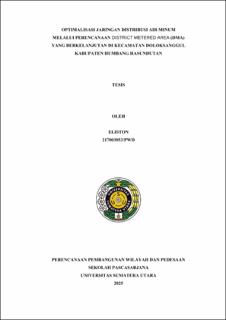Optimalisasi Jaringan Distribusi Air Minum melalui Perencanaan District Metered Area (DMA) Yang Berkelanjutan di Kecamatan Doloksanggul Kabupaten Humbang Hasundutan
Optimization of Drinking Water Distribution Network through Sustainable District Metered Area (DMA) Planning in Doloksanggul District Humbang Hasundutan Regency

Date
2025Author
Eliston, Eliston
Advisor(s)
Kesuma, Sinar Indra
Purwoko, Agus
Metadata
Show full item recordAbstract
Drinking water is one of the basic human needs and is essential for improving the quality
of human life and economic growth in a region. The provision of drinking water through the
piped water supply network in Doloksanggul District currently has a service coverage of
25.61% and a loss rate of 32%, indicating that the drinking water distribution system is still
not optimal. The purpose of this study is to analyze the distribution pattern of drinking water
needs and the zoning pattern of the drinking water distribution system according to regional
characteristics and the rules of the district metered area (DMA) in Doloksanggul District. The
DMA concept is a strategy for managing water loss, especially physical water loss, namely by
dividing an open water supply network into isolated zones with smaller water meters. In this
study, a study was conducted on the formation of a sustainable DMA until 2044 using a GISbased
spatial analysis method. The analysis in this study starts from population projections,
land cover classification, predictions of land cover changes to predictions of the distribution of
drinking water needs using a grid system of various scales. From the research results, it was
found that the density of house connections is on the southeast - northwest axis with Pasar
Doloksanggul Village as the median center, where in 2024 it consists of 12 zones, in 2029 it
consists of 13 zones, in 2034 it consists of 14 zones, in 2039 it consists of 16 zones and in 2044
it consists of 20 zones.
